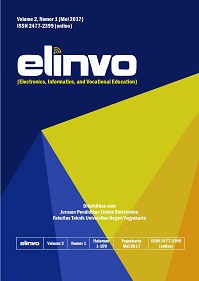Students' Learning Experiences With LMS Tes Teach In Flipped-Class Instruction
DOI:
https://doi.org/10.21831/elinvo.v4i1.24405Keywords:
Flipped Classroom, Technology-enchanced learning, LMS, EFLAbstract
The purpose of this study was to identify the impact of implementing a Learning Management System (LMS) "˜TES Teach' on students' learning experiences in a computer-assisted language learning (CALL) course with flipped-class instruction. For the data collection procedure, an individual interview with ten undergraduate students from an Indonesian college was conducted to demonstrate the potential impacts of the LMS in students' meaningful learning activities. The observation of students' learning activities on the LMS was also recorded to support the interview data. The LMS was adopted to distribute and receive information, thus, the students were able to monitor learning activities, learn the contents before coming to class, evaluate learning process, and interact with others outside of class hours. The finding of this study suggests that the LMS TES Teach is recommended to be performed in teaching CALL for higher education in Indonesia. It offers students' occasion to practice and enhances their listening, writing, reading and vocabulary skills in and out-of-class times. It also prepares students to get ready for classroom activities in term of conversations and speaking skills. The further use of the LMSs should become often-visited sites by students for learning activities and replaced other non-educational favorite websites. Finally, this study recommends that the Ministry of Research, Technology and Higher education or policymakers in Indonesia, including instructors, students, and community members, must be actively involved in developing, supporting, and maintaining a transformed learning culture, from being traditional to a technology-based learning environment.References
I. W. Dirgayasa, "Survey of English teaching and learning process in Maritme education and training in Indonesia: A case study in private MET in Indonesia," English Lang. Teach., vol. 7, no. 7, pp. 111–119, 2014.
G. Ä°lin, í–. Kutlu, and A. Kutluay, "An Action Research: Using Videos for Teaching Grammar in an ESP Class," Procedia -Soc. Behav. Sci., vol. 70, pp. 272–281, 2013.
H. Staker and M. B. Horn, "Classifying K-12 Blended Learning," Innosight Inst., 2012.
J. Ahmad, "English Language Teaching (ELT) and Integration of Media Technology," Procedia -Soc. Behav. Sci., 2012.
B. Derya, "English Language Teaching Students' Perceptions of Computer-Assisted Language Learning," J. Educ. Futur., no. 2, pp. 63–74, 2012.
L. P. Galway, K. K. Corbett, T. K. Takaro, K. Tairyan, and E. Frank, "A novel integration of online and flipped classroom instructional models in public health higher education," BMC Med. Educ., vol. 14, no. 181, pp. 1–9, 2014.
Z. Zainuddin and M. Attaran, "Malaysian students'perceptions of flipped classroom: a case study," Innov. Educ. Teach. Int., 2016.
Z. Zainuddin and C. J. Perera, "Exploring students' competence, autonomy and relatedness in the flipped classroom pedagogical model," J. Furth. High. Educ., 2017.
D. Raths, "Nine Video Tips for a Better Flipped Classroom.," Educ. Dig., vol. 79, no. 6, pp. 15–21, 2014.
M. K. Kim, S. M. Kim, O. Khera, and J. Getman, "The experience of three flipped classrooms in an urban university: An exploration of design principles," Internet High. Educ., vol. 22, pp. 37–50, 2014.
J. W. Creswell and T. C. Guetterman, Educational research: Planning, conducting, and evaluating quantitative and qualitative research, 6th ed. Pearson, 2018.
Z. Zainuddin, "First-year college students' experiences in the EFL flipped classroom: A case study in Indonesia," Int. J. Instr., vol. 10, no. 1, 2017.
T. Gregersen and E. K. Horwitz, "Language Learning and Perfectionism: Anxious and Non-Anxious Language Learners' Reactions to Their Own Oral Performance," Mod. Lang. J., vol. 86, no. 4, pp. 562–570, 2002.
S. S. Liaw, "Investigating students' perceived satisfaction, behavioral intention, and effectiveness of e-learning: A case study of the Blackboard system," Comput. Educ., vol. 51, no. 2, pp. 864–873, 2008.
R. S. Davies, D. L. Dean, and N. Ball, "Flipping the classroom and instructional technology integration in a college-level information systems spreadsheet course," Educ. Technol. Res. Dev., vol. 61, no. 4, pp. 563–580, 2013.
F. Orooji and F. Taghiyareh, "Supporting participants in web-based collaborative learning activities from a holistic point of view: a tale of seven online and blended courses," J. Comput. Educ., vol. 2, no. 2, pp. 183–210, 2015
Downloads
Published
How to Cite
Issue
Section
License
The article published in ELINVO became ELINVO's right in publication.
This work by ELINVO is licensed under a Creative Commons Attribution-NonCommercial 4.0 International License.








